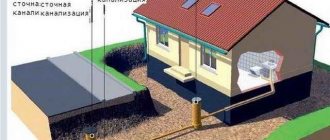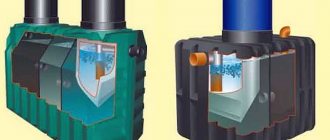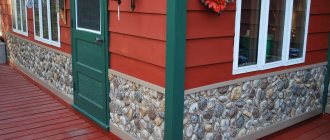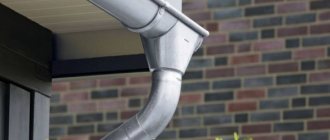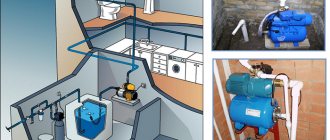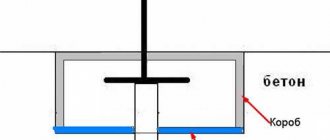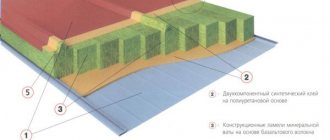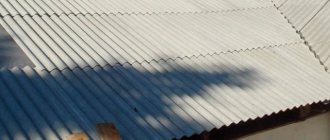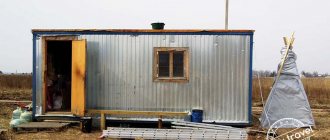Heavy rainfall and spring melting of snow can cause serious trouble for owners of private houses and summer cottages. The large amount of moisture generated during this period contributes to waterlogging of the area, negatively affecting the root system of plants and other landscaping. In addition, excess moisture significantly reduces the service life of residential and commercial buildings and contributes to the spread of mold and other fungi.
The optimal solution to this problem is to lay a storm drain or “storm drain”. The relatively simple design and affordable cost of the necessary materials make it possible to install an effective storm drain even on a small budget.
This article discusses the types, classification, calculation methods and features of storm sewer installation. In addition, recommendations are given for self-assembly of various types of structures.
Features of installation and use of storm drainage
Storm drainage, or storm drainage, is a type of surface drainage. Correctly installed, this system can reliably protect the area from excess water formed due to precipitation
It will be very useful and important for owners of private houses and cottages to learn all the nuances of the preparatory work and the features of the stages of installing a storm drain with their own hands
The very first thing the site owner needs to find out is the composition and structure of the soil. It is advisable to check the groundwater level with surveyors. This is necessary to know whether installing a closed drainage system is necessary
It is also extremely important to choose the right method for discharging water drained from the surface of the site
The discharge of collected water can be organized directly by gravity or by forced drainage pump installed in a well for collecting water. The first (natural) method can only be used if the slope of the site is sufficient for the water to drain by gravity. Otherwise, you will have to create a forced flow of water.
Anyone who lives on a flat area needs to artificially create a pressure of water drained from the site. The water collection point should be installed at the lowest point of the site. Correct calculation of the water intake area is an important stage in the installation of storm sewers. The throughput capacity of the entire water collection and drainage system depends on the volume of the receiving reservoir. The larger the area of the site, the greater the length of the entire drainage system, which significantly increases the number of trays for collecting water and the costs of the entire system.
The cost of the trays themselves depends on the external mechanical load applied to them. It is necessary to take into account where the water intakes should be located: will these be places for pedestrians, or will the channels be laid in places for vehicles to pass through? The weight of the machine itself should also be taken into account when choosing drainage trays. The construction industry produces a line of drainage trays, which are classified depending on the loads they can withstand. There are five categories on the market: from A15 to F 900. The number indicates the possible load. For example, the F 900 is designed for vehicles weighing 90 tons, while the A15 can only withstand passenger vehicles weighing 1.5 tons.
In conclusion, it can be noted that it is quite possible to carry out work on creating surface drainage on your own property, but strict compliance with all requirements for organizing the necessary water flow and proper selection of materials is required.
Drainage systems
There are several types of systems that drain rain and melt water:
- Open type. To drain excess water, this system uses open channels, ditches, and trays.
- Closed type. Water collected by special drainage trays enters stormwater drainage wells (storm inlets), and then into a pipeline network located underground, through which the runoff is directed for discharge. This network may include water treatment facilities.
- Mixed type. In this case, some elements of the open system can be replaced by an underground network of pipes.
Storm water inlet of a closed drainage system
A drainage system must be designed next to each house to remove excess moisture from its foundation. Sometimes overly thrifty owners are tempted to use this system to drain excess precipitation and spring water. Experts do not recommend doing this, since excess moisture will have a detrimental effect on the foundation, leading to its destruction in a shorter time. Designing rainwater drainage is absolutely necessary, and you should not skimp on it.
Step-by-step installation of a storm drain
- The first stage is characterized by carrying out the necessary calculations for designing a sewerage system. First, calculations should be made regarding the drainage of water from structures, since if it accumulates impressively, deformation and destruction of the external walls of the building may follow. The next step is to calculate drainage from hard-surfaced areas (paved parking).
- Having identified areas that need water drainage, a number of actions should be taken to ensure that moisture does not linger there. If we look at the roof of the building, then there are no questions with it - storm water is collected by the drainage system. To preserve the paths of the yard and parking lot from the effects of wastewater, professionals recommend making a slope during construction, and then the water will naturally flow into existing gutters or water inlets. Note that similar moisture interception devices are also installed under the ends of drainpipes, which collect water flows coming from the roof of the building.
- Having carried out the necessary calculations and made drainage gutters and funnels, it is necessary to carry out work regarding the removal of unnecessary moisture into the wastewater treatment system or away from the dacha (suburban) area.
- Drainage to water intakes can be done in two ways:
- open - the water flows into special holes, closed in the upper section with gratings;
- closed - water moves through a system of underground pipes to a collection and disposal point.
- When installing pipes, you must be guided by the same installation principle as with gutters, namely, all structures of the storm system must be placed at a certain slope towards the drainage area. This angle is calculated in the same way as when installing an external sewer system.
- Pipes related to the drainage system are not allowed to be buried too deep into the ground. Storm sewers operate exclusively in the warm season, and they are not afraid of freezing.
- To prevent clogging of the system, it is necessary to install special filters to collect large particles of debris. In addition, it is recommended to install sand traps that effectively filter sand particles. When laying pipes in a closed manner, in the area where filters and sand traps are installed, hatches and inspection wells should be installed for unscheduled drainage cleaning and routine maintenance.
A properly installed storm drain in a private house with your own hands will save the owners of a private house from a large number of puddles, flooding, slush, and will also protect the foundation of the building from gradual destruction.
Installation of the ground part of the storm sewer
Installation of a ground fragment of a storm sewer occurs as follows. It is very important to maintain the correct angle of inclination. A tracing cable is used for this. First you need to mark the land. After this, you can begin working with the ground.
Installation of the ground part
This means digging trenches and inspection wells. This should be done taking into account the depth to which the soil can freeze in winter. In addition, it is necessary to dig grooves for installing trays or gutters.
Now you need to install receivers to collect rainwater.
It is necessary to pour a small layer of sand into the dug trenches and tamp it down.
After this operation, you can lay the pipes in the places provided for in the diagram.
The next step will be to connect all parts of the sewer system to each other, after which it will be necessary to install filters and protective grilles.
At the last stage of installation work, it will be necessary to install receiving trays on cement mortar and bury the lines.
After completing all the work, it is necessary to conduct a test, which consists of artificial “rain”, you will simply need to turn on the water and direct a stream of water to the area with the installed system. If the system copes normally, then the installation can be considered complete. Such a sewer system will last for many years, but only if used correctly.
Return to content
Carrying out installation work
As with any construction, all the necessary preparatory work takes place at the very beginning. At the first stage, a site plan is marked on paper and a drawing of the future drainage system is made, then the necessary calculations of building materials are made.
Next, the actual preparation of the channels for future drainage begins. Trenches must be dug with a depth of at least 10 cm and taking into account the fact that decorative grilles are installed with a slight penetration into the ground. After the channels have been dug and the foundation has been created, they begin pouring the concrete mixture. The thickness of the concrete layer is about 10 cm. Then sand traps are installed in the concrete and plastic gutters are laid on them. To obtain the highest quality and durable drainage, it is recommended to additionally perform waterproofing: lay a waterproofing material (roofing felt or roofing felt) between the gutters and concrete.
The final stage includes connecting the drainage system to the sewer system. This is done using a pipe. To top it off, decorative protective grilles are installed.
Types of drainage systems
There are two types of drainage systems used to drain water from a site. These are deep (closed) drainage and surface drainage. The operating principle of each system comes directly from their name.
Surface open drainage performs the function of removing melt water and rainwater from the open area of the site and the road surface. The operating principle of such a drainage system is based on the collection of excess water and its subsequent disposal into the created sewer network.
The surface drainage system consists of open water intake trays and storm water inlets. For safety and ease of maintenance of the drainage system, all its installed elements are equipped with removable steel or cast iron grates, siphons and waste collection baskets. This configuration allows you to create high-quality and durable surface drainage on your personal plot of land.
Closed (underground) drainage is designed to lower and remove groundwater close to the surface from the site. This drainage system consists of a system of drainage pipes laid in the soil at the required depth.
To create this system, ditches, inspection wells and settling tanks are dug on the site in the required places. A layer of sand mixed with fine crushed stone is poured inside the ditch into which the pipe will be laid.
The installation of inspection wells and settling tanks is very important and necessary to control the level of rising water and carry out its purification. A deep closed drainage system must be used in areas with a close approach to the groundwater surface and if the site is located in a wetland or lowland
The two presented drainage systems - closed drainage and surface drainage - do not replace each other, as they perform different tasks for draining water from a developed area. There is no point in installing an underground drainage system if the site is located on a hill or if the groundwater flows below the level of 1.5 meters.
If it is necessary to install a deep drainage system, special attention should be paid to the installation of an open drainage system. Properly executed surface drainage helps reduce the length of the deep drainage system
Thus, the volume of construction work can be significantly reduced and savings in labor costs and equipment costs can be achieved.
Compound
Drainage trays, gutters. They are laid with a slight depth (the upper edges reach the level of the ground, road surface), with a constant slope towards the wells and spillway point.
Materials:
- plastic. Polypropylene is used for production - durable, resistant to aggressive chemicals, UV rays, and temperature changes. The design of plastic trays is reinforced, with stiffening ribs. Suitable for pedestrian areas, areas near residential buildings, parking lots, access roads with light traffic;
- concrete. Concrete gutters are used for areas with high loads and have a large margin of safety. Resistant to mechanical damage, moisture, and aggressive chemicals.
Drainage gutters and trays are covered with protective grilles (can be plastic, steel, cast iron). Grids are selected taking into account the expected loads on the road surface. Plastic is used for pedestrian areas, playgrounds and sports fields. Galvanized steel gratings - for passenger vehicle parking lots and unloaded driveways. Cast iron gratings have a large margin of safety and are suitable for highways and parking lots where trucks can enter.
Point storm water inlets. These are containers closed with gratings that are connected to an underground pipeline. They are installed in places of point water collection - under the risers of drainage systems, at the lowest points of the slope. The storm inlet is buried so that the grate is flush with the ground, road surface or blind area. Additionally, waste collection baskets or siphons are installed inside the rain inlet, which collect leaves and large debris and protect the storm drain from silting. Stormwater inlets are made of plastic, protective grilles are made of plastic or steel.
Pipeline. It is laid with a constant slope to the drainage wells or spillway point. Connects to storm water inlets and combines with drainage trays. To install the underground part of the storm sewer, PVC pipes are used; the diameter is selected taking into account the required performance of the system. If there is a risk of storm sewer freezing, it is better to increase the diameter of the pipes. Connections of pipes with each other and with fittings, with drainage trays and storm water inlets must be airtight (they are made using couplings, sealant, etc.).
Wells. Several types of wells are used for linear drainage. Inspection wells are installed in sections where the underground pipeline turns and in long straight sections. They are used to monitor the condition of pipes and to clean the system in case of silting or blockages. Drainage wells are installed at the lowest points of the pipeline, and pipes are discharged into them. These are large-volume containers in which collected water accumulates. If there is nowhere to dump water (there is no reservoir, ravine, etc. nearby), the water is pumped out, and it can be used for irrigation and technical needs. For storm sewerage, it is possible to install absorption wells (water is drained into deep layers of soil), drop-off wells (used for areas with a large slope to ensure water flow with a large difference in elevation).
Main stages of installation of a drainage system
Equipping a country house with a stormwater system can be done independently. To do this you need to do the following:
- install brackets;
- install and secure gutters;
- fix the drain pipes and their holders;
- arrange the drainage of excess liquid to a pre-selected location.
All connections are checked at every stage of the work.
Installation of drain brackets
To secure the brackets, you need to maintain the distance between the gutter and the wall, which ranges from 60-80 mm. In this case, condensation does not form. The installation of elements is done in compliance with the slope of the system. It is 5 mm for each linear meter of structure length.
First, the brackets are marked. With a roof slope length of about 6 meters, the height difference at two points - the first and last - is 60 cm. A gap of 100-150 mm must be maintained from the edge of the roof to the fastening element. The pitch between adjacent brackets ranges from 50-60 cm for metal structures and 30-40 cm for plastic ones.
First, the first upper element, which is located on the opposite side of the drainpipe, is fixed. The last, lowest bracket is screwed in next, after which a string is pulled between the fasteners and the remaining fragments are marked. Standard self-tapping screws are used for installation.
The funnel must be installed at a distance of 30-60 cm from the edge of the gutter, and fixation is made 15 cm from it.
Installation of gutters
They only need to be assembled and fixed on the brackets. The method of fastening depends on the type of system and the material of its manufacture.
Installation of waste pipes and holders
This is the last stage of assembling the structure, at which pipes for draining water are installed strictly under the opening of the storm funnel. To fix them, clamps are used, which are screwed to the wall using dowels at a distance of up to 200 cm from each other.
Where is rainwater drained from the roof of a house?
After the system is installed, you need to organize a place where rainwater will be collected. There are several options here:
- Capacity. A barrel is dug into the ground at a distance of 0.5-1 m from the building, towards which the drain elbow is directed. It can also be installed on the ground surface. The collected liquid is used to water home or garden plants.
- Filtration well. It is a pit, the bottom of which is covered with rubble. After this, a well of concrete rings is installed.
- Sewerage. Here you must first obtain permission from the relevant utility services.
- Drainage or pond.
A filtration well is a hole, the bottom of which is covered with crushed stone.
Storm drainage is a mandatory structure that allows you to protect the foundation of a house and its walls from the destructive effects of rain and melt water.
Types of stormwater system
Water enters the storm drain directly in a closed way or openly through a grate and drain elbow. Each type of stormwater system has its own characteristics, which must be taken into account at the design stage and then used during installation.
Open surface drainage
An open drain means a system of gutters, channels through which water will flow into a specially designated place or simply into the ground (for example, a vegetable garden). This drainage system is efficient and economical. It is important to consider that surface stormwater will freeze. Therefore, it is most often used in summer cottages and private houses.
With an open type of drain, you need to carefully calculate the height at which the drain elbow is located so that you can periodically remove the grate and clean the storm drain basket. The tiles or asphalt should be 3-4 mm higher than the level of the grid with trays. The general slope is directed towards the drainage trays. From there, the liquid reaches the general storm sewer. The required slope of the gutters is organized taking into account the design of the gutters and the features of the landscape.
Closed underground drainage system
This system is located below the zero point and involves working with the soil. Unlike an open system, which can be installed by an amateur, this type of drainage system must be carefully designed and installed by a specialist. This storm drain is relevant for industrial enterprises where a large amount of wastewater is expected, especially if it is contaminated and requires pre-treatment before being discharged into a reservoir or ground.
A closed or underground version of a storm drain is installed with a slope of 3 cm per linear meter in relation to the storage well. To facilitate the planning of the slope, a sand cushion is used. A pipe system is being laid underground through which water will flow into the collector.
Mixed type
This is the most common type of storm drain, which takes into account all sanitary and hygienic standards. It contains elements of both an open system and a closed one. Mixed storm sewerage is used when it is necessary to save on the arrangement of the system. It also helps to cover a much larger area.
Roof drainage components
The storm system consists of the following elements:
- Gutter This is the main part of the structure, which is fixed directly under the slope of the roofing material and receives water flows. It is installed along the perimeter of the structure at a slight slope.
- Funnel. With its help, water is directed into the drain pipe. To prevent the entry of large debris or leaves, it is better to equip the funnel in its upper part with a protective mesh.
- Elements for draining liquid into the sewer.
- Internal and external corners. Used in complex structures.
- Couplings. They serve to connect gutters if the structure is long.
- Knee. The element is installed at the bottom of the drain and removes liquid further from the structure.
- Brackets and clamps. These are connecting elements for pipes and fixing gutters.
- Stub. It is installed to limit the flow of water.
Couplings are used to connect gutters if the structure is long.
You can purchase either a standard system or order the production of an individual project.
Laying rainwater drainage installation features
As a rule, storm drainage on a site is installed exactly according to the same principle as sewerage in a house, and the differences between them are observed only in materials and assembly nuances. The most important difference is the slope, which in this case is 3-5 mm per 1 m of a gutter or pipe - it is this slope that allows the flow of water to safely carry away all the debris and not deposit it on the pipes. In addition to this nuance, we can highlight a lot of other points related to the direct installation of rainwater drainage.
- Instead of plumbing fixtures, this system uses water inlets - as mentioned above, they are installed either in places where water is likely to accumulate, or directly under drainpipes.
- The discharge point in this system is not the central city sewerage system, but a lowland, a river, a beam or simply a drainage pit - it should be noted that the pit is made separately for rainwater drainage.
- All water intakes are combined through inspection or inspection wells into a single pipeline through which the water flows to the discharge point. A well is a tee through which, among other things, you can always clean drainage pipes.
- Polypropylene pipes are placed on a sand cushion, the thickness of which should be at least 5-10 cm. It is this cushion and the bottom of the trench that forms the slope of the pipes.
- The initial backfilling of pipelines is also carried out using sand - do not throw stones or soil with debris directly onto the pipes. During operation, soil movements occur, and these stones will very quickly disable the rainwater drainage system.
- A filter funnel is installed under the drainpipe (in front of the storm inlet), the purpose of which is to retain large debris and prevent it from penetrating into the system of pipes and gutters.
In principle, there is nothing complicated here, but for such a system, or rather for specialized material, you will have to pay a lot of money - an open rainwater drainage system is much cheaper to manufacture yourself. You will also have to buy material for it, but there is one option - it is made of concrete, and no one will stop you from buying molds for them instead of ready-made trays and casting the gutters yourself. This is a simple process that almost every man can handle.
The only thing I’ll add in conclusion to this topic is to remind you that if you are interested in a really good rainwater drainage system that will not spoil the interior of the site with the appearance of its gutters, then it is better to choose a closed underground installation system. Yes, it is more difficult to manufacture, but it has many advantages.
Do-it-yourself storm drainage - installation features
It is worth noting that installing a storm drain in a private house is within the capabilities of any owner who has the appropriate knowledge and basic experience in construction work. The main difficulty lies in drawing up drainage plans and drawings and carrying out the necessary calculations.
Self-manufacturing of gutters
Theoretically, storm drainage can be made in a private house with your own hands without using commercial trays. To do this, dig a trench in the ground with or without a slope, lay formwork from boards and fill it with concrete or cement-sand mortar, being careful not to fill the middle.
Then a piece of smooth-walled PVC-U pipe with a diameter of 110, 125 or 160 mm (its walls are pre-lubricated with used machine oil) is pressed halfway into the fill, preferably 6 m long, at the desired angle (average slope 7 mm per linear meter), the excess solution is removed. The pipe is left until the solution dries completely for 1 - 2 days.
Since the surface of the resulting gutter will not always be smooth due to the lack of vibrations, after filling it you will have to seal the cracks and cavities. You can do it in a more efficient way by cutting the forming pipe lengthwise and leaving half of it in the tray forever.
A home-made gutter obtained by this method has a number of advantages over a purchased one, related primarily to financial savings and the high quality of a single line of stormwater system without butt joints.
If necessary, it is easy to make trays yourself in a similar way. To do this, make a rectangular shape from boards, lay an inverted PVC pipe cut lengthwise, greased with oil on the bottom and fill it with concrete. To compact the concrete mixture, they use artisanal vibration - they place the form on the tire and hit the rubber through the board with a hammer drill in the bumper mode.
Rice. 16 Examples of self-made gutters
Installation of storm drainage from ready-made trays - recommendations
Linear (trough) storm drainage in a country house or cottage is designed to provide water collection and drainage from the hard surface of large areas; sometimes it is also used for lawns.
When arranging a tray sewer system, it is useful to be guided by the following considerations:
- When carrying out excavation work, make a slope of the site with a hard surface (paving slabs) towards the flume channel of about 0.5% or 5 mm per linear meter. The slope may be less if a smooth asphalt or concrete waterproof covering is laid.
- If the drainage occurs from the blind area around the building into a linear sewer, its slope is much greater, for example, at least 2.5%, similar to the road surface (25 mm per linear meter).
- To direct stormwater to the drainage structure, the trays will have to be sloped. In concrete structures, the manufacturer lays a slope directly in the trays themselves at 0.5 or 1%, forming them into a continuous line of different heights. The user can only connect these gutters into a single highway.
Rice. 17 Scheme of laying linear sewerage
- Polymer trays are made without a slope, so when constructing a sewer using them, you will have to tilt the entire site along with them by 0.5 - 1%. The second way out of the situation is to use a cascade connection of trays of different heights, which are produced by almost every commercial company that manufactures them.
- When installing a tray sewer, the following operations are carried out:
- Dig a trench, the overall dimensions of which depend on the size of the trays and the thickness of the concrete base at the bottom and sides. Sand is poured into the bottom of the trench in a layer of about 30 mm to level it, then the sand cushion is compacted.
- Place a layer of concrete 50 - 100 mm thick (depending on the load class) at the bottom of the ditch, lay trays on top and level them to the level of the site. Polymer products are connected into locks, the joints are coated with sealant.
- The straightness of the laying of the trough line is checked with a pre-tensioned cord; individual gutters are checked with a metal level; if adjustments are necessary, they are tapped with a rubber mallet.
Rice. 18 Tray storm sewer - installation stages
- When laying, make sure that the height of the linear tray drainage with the lid on is 3 - 5 mm below the level of the site covering.
- Also, the side walls of the trays are covered with concrete or a cement-sand mixture, leaving space for laying paving slabs. To prevent the ditch from crumbling, to have the same filling thickness on the sides, and in order to save material, boards of the appropriate width are laid on the side walls of the trench, thus forming a kind of formwork.
- If further pipe drainage is necessary, a sand trap is installed at the end of the flume line and a pipeline is connected to it.
- After the concrete or cement-sand mixture has hardened, the trays are covered with lids and paving slabs are added. A damper tape is placed in the narrow space between the street covering and the trays to compensate for linear deformations.
Rice. 19 Storm sewer - laying diagram and main components
Why do we need a storm drain?
Stormwater systems have been known since ancient times and their effectiveness has been proven by time. A well-thought-out storm drainage scheme will help you get rid of many problems:
— radically reduce the number of puddles in the yard and get rid of ice;
— reduce the risks of destruction of sidewalks, blind areas and building foundations;
- eliminate the possibility of dampness on the first and basement floors;
- almost completely eliminate moisture from entering the basement;
— eliminate the process of soil waterlogging or soil erosion;
- does not worry about preserving the aesthetic appeal of the local area and the building itself.
And most importantly, the storm system helps prevent oversaturation of the soil with moisture.
Types of storm drains:
Spot. The principle of operation of the sewer system is an organized network of storm water inlets and connecting pipes. Protective gratings and special sand catchers, a kind of filters, must be installed on rainwater inlets.
Linear. Such a sewer system is a network of channels that allows you to collect and transport water flows, sloping towards the collector. If the required slope in the landscape cannot be achieved, then slopes are installed to pump water.
Storm drainage has another classification:
— Open type, considered the simplest, both in terms of installation work and design. The cost of installing such a storm drain is minimal. The principle of operation is also the simplest - open gutters and channels collect and discharge surface runoff;
— Closed type. A system with rainwater inlets and a closed or underground piping system;
- Mixed type. A stormwater system is a combination of an open and closed system. It is rational to use such a system on large plots of land.
Stormwater systems are divided according to the type of drainage:
- Move to the side. Such a system involves the construction of a foundation blind area for the accumulation of rainfall;
— Retraction down. In this case, the water is discharged pointwise and the system must have a grate to contain dirt.
Plastic storm sewer - choosing materials
Plastic storm drainage is a fairly popular issue, because in water supply and wastewater systems today plastic parts have no equal. However, part of the storm drainage system is still made from other materials, for example, metal gratings not only perform their functions well, but can also serve as an additional decoration for the site.
Let's take a closer look at all the elements of storm drainage and the materials from which they are made:
- Storm water inlets and gutters - the most popular materials are plastic and concrete. There are metal options, but due to susceptibility to corrosion and significant noise when water falls, they are rarely used. The easiest way to install is plastic, while concrete elements look good on the exterior.
- Grates – can easily be found in aluminum, steel or cast iron. Here you should pay attention to aluminum - it is the most durable and convenient, but such grilles are more expensive than analogues made from other materials. Cast iron can also work, but you'll need to repaint every 2-3 years. Steel is rarely used - it is susceptible to corrosion and is not very practical. When choosing a grate, you should also pay attention to the size of the cells - on the one hand, they must allow significant volumes of water to pass through, and on the other, they must retain debris.
- Pipes - here, undoubtedly, PVC is in the lead. Polyvinyl chloride pipes are widely used in the construction of both storm and domestic sewage systems; they have proven themselves, are easy to install and are affordable. Considering the constant location of pipes in a humid environment, it is not worth even considering metal options. For the installation of storm drains, it is recommended to use pipes with a diameter of 110 mm or even larger if the roof area and the volume of precipitation are significant.
- A collector is an element of a mixed and closed system that accumulates water from storm sewers. Can be made of concrete rings, polymer materials or bricks.
We examined only the main elements of storm drainage; as mentioned above, when arranging complex systems, it is possible to use other elements, for example, inspection wells, drainage elements or automation.
Gutter as one of the main and important components of the device
One of the main structural elements that receives water from the roof. There are several varieties of it: wall-mounted or hanging. Plastic, galvanized metal or copper are used for manufacturing.
Wall
It is localized close to the overhang of the roofing material at the very edge of the roof. The product is a side, up to 20 cm high and acts as a barrier to rainwater. Such gutters are installed at an angle to the overhang and directed towards the drain funnel. To connect the trays, glue or a double lying flange is used. Their tilt angle is 15 degrees, which prevents liquid from overflowing over the edge.
Rain or hanging
It is tightly attached directly under the roof overhang, which prevents accumulated liquid from flowing under the gutter. For fixing, steel hooks are used, shaped to match the product. Since this fragment does not bend, in order to avoid overflowing, a hole must be made in it in a pre-marked place. When calculating the slope in this case, the amount of precipitation that fell during the year is taken into account.
Classification of gutters
The following types of gutters are distinguished by shape:
| Variety | Characteristic |
| Semi-elliptical | Copes well with large flows of water, as it provides greater throughput |
| Semicircular | It is resistant to loads and has a high level of rigidity. This gutter is universal, as it is used on most roofing structures. |
Gutters are also classified according to the material of manufacture:
- Plastic. They have an attractive appearance, light weight and low cost. With proper fastening and use, the service life is 15-25 years. You can install them yourself. Such fragments are secured using couplings or latches with rubber seals. Sometimes glue is used for fixation. But such products have a high risk of mechanical damage and become brittle at subzero temperatures. Small scratches on the surface can be masked with acrylic paint.
- Aluminum. For connection, fasteners with rubber and silicone seals or specialized glue are used. Untreated material can quickly become rusty. A layer of varnish will help avoid this.
- Galvanized. They are metal products with pre-applied polymer protection. Characterized by a wide range of colors. For fastening, brackets with latches equipped with rubber seals are used. Such gutters are highly durable and do not corrode unless the polymer layer is damaged. The disadvantage is the frequent lack of the correct shape, which complicates the assembly of the system.
You can also buy copper products in stores. They are durable, rust-resistant, have an attractive appearance and a long service life, but they are expensive.
Copper rainwater is durable, corrosion-resistant, has an attractive appearance and a long service life, but it is expensive.
How to calculate gutters correctly?
The standard element length is 3-4 m. For small buildings, products with a cross-section of 70-115 mm are sufficient. On large structures, gutters with a cross-section of up to 200 mm are installed. It is necessary to calculate the specified fragment so that the distance between the nearest craters is 8-12 m.
Assembling the gutter design
If the length of the gutter is more than 12 m, then several fragments of fasteners connected to each other are required. After this, plugs are installed at the edges of the structure and it is fixed on the brackets.
Classification of internal drainage systems
There are two systems of internal drainage for multi-storey buildings:
- gravity;
- siphon
The gravity system is as simple as possible. It consists of a gutter running along the eaves of the roof, directing water into a vertical downpipe. Along with water, air enters the sewer system, which reduces the amount of water passing through the pipe. A clear example of this fact is a drainpipe; everyone can compare its diameter and the flow pouring out of it even in heavy rain.
Elements of the drainage system
The siphon system connects the water intake funnels on the flat roof of the house into a single horizontal network of pipes, which, using an L-shaped elbow, turns into a vertical drain. The design of the siphon system is more productive, more progressive. The design of such a system prevents air from being sucked into the stormwater pipelines, so internal drainage will require conduits of a smaller diameter than would be needed for the installation of a gravity-type stormwater system.
Siphon system of internal drainage
How to correctly calculate the number of pipes for drainage
In order for the structure to work correctly, it is necessary to calculate the required number of its elements. Their cross-sectional area should be sufficient to ensure that water flows through the edges of the gutter without stopping or overflowing even during the heaviest rains.
When choosing structural elements, you need to take into account the roof area, pipe cross-section, and climatic operating conditions of the storm drain. The standard value is: 1 sq.cm. cross-sectional area covers 1 sq.m. roof area. For small houses, a drain fragment with a diameter of 50-75 mm will be required. For large structures this value increases to 160 mm.
Calculation as an integral part of the work performed
Without carrying out the necessary calculations, you can forget about the positive result of the task being performed. In the event that the storm drain does not cope with its intended function, then there is no need for its installation. In addition, when creating a larger storm drainage system with your own hands, there is a risk of investing a larger amount of money. In this regard, there is a need to recalculate all possible costs. To ensure accurate calculations, finding out the following information will help:
- Physical and chemical properties of soil.
- Drainage area.
- Data on the average amount of recorded precipitation in your region and region. To obtain this information, you can contact SNIP.
- Information about accessible communications located underground.
- When planning the drainage of melt water, it is necessary to take into account the frequency of precipitation and the thickness of the snow cover.
Standard equipment of the storm system
A modern stormwater system contains interconnected elements:
- Storm water inlets . There are usually several of them. They are points for collecting water from vertical external drains and from the surfaces of blind areas. They have a basket in which garbage is collected. Stormwater inlets are installed in lowlands, near intersections, and under gutters near buildings. To prevent the spread of unpleasant odors from the sewer, a siphon is often built into them.
- Door pallets . They work the same way as rainwater inlets - they collect water directly from the building in front of the entrance.
- Gutters, channels, trays , which are equipped with lattice covers. Used in surface drainage. The base is made of concrete or plastic, and the grate is chosen from plastic, stainless steel or cast iron. These elements are used to reduce the length of the pipeline.
- Sand catchers . It is through sand traps that water enters the general sewerage pipeline. Consists of a base and a basket. The latter is designed to capture suspended particles. It is periodically removed for cleaning (cleaning is carried out twice a year). It is suggested to use two or more sand traps to prevent the system from becoming clogged with debris.
- Inspection well with sump . Installation of this container is carried out at branching points, at the corners of the underground part of the stormwater system. Through such tanks, drainage lines are cleaned and dirt is removed. Used in closed or mixed sewer systems.
- Pipes . Non-pressure plastic products are installed. For this, orange (red) pipes are usually chosen.
- The laying of an external storm sewer system is carried out from the drainage points related to the external drainage system to the beginning of the underground part of the system.
When the length of the storm drain is more than 100 meters, the installation of one or more inspection wells is required at the point of integration and at the corners of the underground pipeline, which depends on the volume of water and the scale of the entire system.
Typology of storm sewers
In order to learn how to make a storm drain with your own hands, you need to familiarize yourself with its types:
- Overhead type. The main feature of such storm drains is that the gutters that perform the drainage function are located in the coating. With their help, water enters a specially designated place or flows into a vegetable garden or garden on the site.
- Underground type. All components of this type of sewer structure are located below ground level. The design fits organically into the exterior of the yard. However, for its installation, it is necessary to perform a huge amount of earthwork, accompanied by large financial costs. You can equip your home with this system with your own hands when remodeling your site or building a new cottage. In turn, they are divided into two types:
- non-freezing;
freezing.
- Mixed type. The name speaks for itself. Part of the structure is made from above, and the other part is made in the ground. This option combines a huge number of advantages:
- small amount of necessary building materials;
- relatively low financial costs;
- aesthetic appearance.
Anti-freeze rainwater should be laid below the depth of soils subject to freezing. Each region has its own level, which on average is from 1.5 to 1.7 meters. As for the freezing structure, its depth on average is less than a meter, however, this storm drainage system at the dacha may function unstably in the winter and spring seasons.
However, almost always, you have to produce an individual project. This is explained by the fact that each site has a number of features:
- layout;
- soil moisture absorption;
- development;
- terrain.
Order turnkey storm drainage
We have already said that you can make a storm drain yourself, but this system will not only protect the area from puddles, but also protect the foundation, which means it must work 100% correctly. Today you can easily order a turnkey storm sewer system and spend not so much money compared to installing it yourself (you still have to buy materials) - but this money will easily be recouped by a guarantee of quality, the absence of nervous tension and saved time.
The Mosvodostroy company is engaged in the installation of turnkey autonomous sewage systems, as well as the creation of individual water supply and heating systems in suburban areas - we know how to make your home comfortable. To receive a consultation, simply fill out the application.
Kinds
Surface drainage is designed to protect the site from excess rain and melt water. This system is especially popular among homeowners who take a responsible approach to the arrangement of private territory and the protection of buildings. Installation of an open drainage system prevents subsidence and destruction of building foundations, asphalt surfaces and paved paths, and protects tree roots from excess moisture.
Surface drainage is represented by two types:
- linear;
- spot.
Linear drainage consists of deep gutters stretched across the site, mounted from plastic or made of concrete. Such a system is installed in areas occupying large areas.
Design and installation diagram of linear drainage systems
Point drainage is a system of storm water inlets connected to storm sewers. This system also includes sand receptacles designed to prevent sewer clogging. The guys from .
There is no point in comparing these two types of drainage; each of them complements each other. Experts, for more practical and high-quality water disposal, recommend combining these two types. In this case, drainage will be as efficient as possible.
Design and arrangement of point drainage
What is a storm drain?
Storm drainage (storm drainage system, storm drainage system) is a complex engineering structure that is designed to organize the drainage of excess water resulting from precipitation and melting snow outside municipal territories and private areas. Through external storm sewer networks, rain and melt water are discharged into reservoirs, collectors or ordinary roadside ditches. A drainage system is being developed to collect and dispose of groundwater. As a rule, drainage and rainwater systems are laid at the same angle, parallel to each other. A modern rainwater drainage system is a series of separate elements that are closely interconnected and complement each other.
These elements include storm gutters (gutters, channels), sand traps, rainwater inlets and inspection wells, as well as sewer pipes and collectors. Rainwater drainage can be either open or closed. From open-type rainwater drains, water will be absorbed into the ground through gutters and channels located on the surface. The organization of a closed storm sewer involves the laying of large concrete pipes and the construction of a storage facility for the water coming from them. The pipes must be deep enough to avoid freezing in winter. There are also mixed-type structures on the market, combining elements of both open and closed sewer systems.
It is necessary to design a storm sewer system as a comprehensive system of engineering communications, because the organization of effective drainage of wastewater from the surface depends on how well it is constructed. If the system provides for the reception of contaminated wastewater (from enterprises, gas stations), treatment devices are installed in it to ensure the retention of gasoline, oil and oil products that can get onto the asphalt from various cars and motorcycles; in addition, insoluble mineral contaminants are subject to detention and subsequent disposal - sand, soil particles, etc. Storm water treatment in most cases occurs using sedimentation, coalescence and filtration technologies through special sorbents. If it is necessary to purify wastewater with high concentrations of pollutants, or if it is planned to use retained products in the future, I use energy-intensive technologies, including flotation.
Design of a storm drainage system
The arrangement of storm drainage systems, as well as the construction of any facility, begins with drawing up a project. However, the design of the rainwater sewer system is created depending on the conditions in which it will have to function. Currently, there are the following options for installing storm drains:
- Closed systems. This is a rather complex option for storm drainage, requiring careful calculations and meticulous planning, so in this case the design is entrusted exclusively to professionals.
- Open systems. They are considered the least expensive and the simplest option. When drawing up the scheme, it is planned to install open gutters where wastewater will be collected.
- Mixed systems. An intermediate option between open and closed systems. It is very popular in a situation where it is necessary to significantly reduce the costs of constructing a large-scale facility.
Also, when designing and drawing up a diagram, it is necessary to answer the following questions:
- What is the average amount of precipitation in the area where storm drainage is planned? The answer to this question will help determine the performance of the future system.
- What is the total area of drainage surfaces available on the site (concrete and asphalt areas, roofs of buildings, etc.)? Thanks to this parameter, you can determine the number of rainwater inlets that need to be installed.
- What are the features of the relief? Since trays and pipes are always laid at a certain slope, it is necessary to take into account the differences in heights at the installation site of the storm sewer.
- What type of storm drainage system can be installed in this case? Internal storm sewerage, assembled from pipes laid underground, is not only the most expensive, but also a very labor-intensive option. That is why preference should be given to external (open) rainwater drainage collected from open trays. In this case, it makes sense to place trays along paths, near the building itself and in those places where water flows.
In addition, when drawing up a storm sewer scheme, it is necessary to minimize the number of additional connections and completely eliminate (if possible) sharp turns of the pipeline.
Storm drainage in a private house
Storm sewerage in a private house is a system consisting of several main elements:
- Gutters and storm water inlets.
- A pipe system, including one combined with drainage.
- Sand and grease separators.
- Distribution and control well.
Also, storm drainage in a private house may contain a filter system. In some cases, if sewage treatment plant manufacturers allow storm water to be discharged into them, such sewage can be discharged into a septic tank along with household wastewater.
Please note: Most manufacturers of local treatment facilities indicate the impossibility of draining storm sewer systems into such installations, especially if the sediment contains impurities of petroleum products, toxic substances or heavy metals. This is primarily due to the fact that such compounds can lead to the death of bacteria that are necessary for the process of cleaning household waste.
The principle of operation of storm sewers is quite simple: through special gratings or a drainage system, precipitation enters the system, is collected, cleaned of large debris and fats using sand traps and gasoline grease traps and enters a filter well, storage tank or special tank, the water from which, after cleaning, can be used for watering.
Please note that the use of water from storm sewers for household needs is possible only after laboratory tests are carried out to identify harmful compounds in sediments, as well as in the final reservoir of the storm sewer. If studies show the need for additional purification of such waters, they cannot be used for irrigation, but should be drained into a filter well.
Storm drainage in a private house usually has a linear structure and is buried in the ground, which allows it not to disturb the landscape of the site and save space even when using large elements. If it is not possible to carry out deepening (or it is not cost-effective), a storm sewer is created from a system of open gutters sloping towards the distribution well.
The creation of storm sewerage in a private house is regulated by SNiP 2.04.03-85, as well as SanPiN 2.1.5.980-00. Storm sewerage is a rather complex system that must meet a number of requirements, so in most cases it is better to entrust its creation to specialists. Of course, professional installation may be more expensive, but it will guarantee the efficient operation of the stormwater system, as well as its durability and functionality, even in areas with difficult terrain or soil.
Where is storm drainage required?
First of all, rainwater drainage needs:
- cottage villages;
- places where vehicles accumulate (gas stations, transport bases, garages, parking lots);
- hypermarkets;
- warehouse complexes;
- plants and factories.
In addition, storm sewers must be installed in places where wastewater (from atmospheric precipitation) can be contaminated with petrochemical products and other substances when washed off roads, sites and various devices. The use of rainwater drainage at such facilities allows you to protect water bodies and soil from derivatives of technical oils and gasoline.
Development of a storm sewer project
To perform a competent calculation of rainwater drainage, you must have information on the following issues:
Linear storm drainage system on site
- Statistics on precipitation in a specific region (average and maximum values).
- A terrain plan indicating elevations, allowing you to determine the terrain and choose the most optimal route for draining rainwater.
- Information about the presence of nearby bodies of water and groundwater levels.
Based on these data, the catchment area and the direction of laying individual sewer lines are determined (the line is traced). Depending on the terrain and the expected abundance of precipitation, the places where receiving chambers and rainwater drainage wells will be installed are determined.
This effect is achieved by optimizing the network, selecting the minimum required number of storm water inlets, and the optimal pipe diameter.
Installation of storm sewer networks and structures
If you plan to install a storm drain yourself, you should carefully follow the recommendations and carry out the work consistently. Briefly, the installation of a storm sewer system looks like this:
- The roofing part of the storm drain is installed - in the openings of the ceiling it is necessary to install rain inlets on bitumen mastic and install risers and gutters.
- Using stretched ropes, they mark out the area and carry out excavation work - digging trenches for pipes, recesses in the locations of inspection wells and a foundation pit for the collector. To prevent freezing, the depth of the trench must exceed the freezing depth of the soil.
- Fill the trench with a layer of sand, which avoids soil subsidence and changes in the slope of the pipes. In heaving soils, the bottom of the trench is also sprinkled with crushed stone.
- The collector, storm water inlets and wells are installed, after which they proceed to the installation of storm sewer pipes.
- Before backfilling trenches, you should check the storm sewer system for leaks and correct the situation if leaks are detected.
The process of arranging storm drainage is completed by backfilling the trenches. In principle, these are all the basic steps that need to be performed when installing a simple storm sewer; of course, if you want a more complex system, there will be more work.
How does a storm drain work?
Stormwater treatment systems in most cases consist of several fiberglass containers installed one after the other. The wastewater treatment process begins with a distribution well, from which atmospheric precipitation enters the sand separator. Large suspended sand particles are deposited in the sand separator, and the liquid flows into the oil and gasoline separator, where the gasoline film and oils are removed. After this, the wastewater, already freed of most of the contaminants, enters a sorption filter designed to capture petrochemical products emulsified in water. The finally purified liquid is collected in a control well, from where it flows into a ravine, reservoir or receiving well. Thus, the main components of storm drainage are five main components:
- Distribution well.
- Sand separator.
- Oil catcher.
- Filter-adsorber.
- Control well.
In some cases, the additional installation of a UV well and storage tank is recommended. But in any case, a storm drainage system buried in the ground is absolutely invisible and can be installed anywhere, since it does not cause deformation of the road surface.
Ideally, all components of a storm sewer system are structurally combined into one line, which guarantees the greatest possible compactness of the structure. If the system channels are laid in the ground, then pipes are used to create them. Surface ditches are equipped with trays and gutters made of concrete, asbestos or plastic. The main feature of storm drainage is the laying of gutters, trays and pipes with a slope towards drainage devices and discharge points in order to organize the natural movement of melt and rainwater.
The water obtained at the outlet of the storm sewer contains no more than 30 mg/l of suspended solids and less than 0.05 mg/l of petroleum products, so it can be used for land irrigation, for watering agricultural crops, and for discharge into fish-breeding reservoirs.
A little about the depth and slope of the pipeline
In order to correctly determine the depth of immersion of pipelines into the ground, it is necessary to use the recommendations given in SNiP 2.04.03-85, according to which the minimum depth should be determined by the experience of operating similar engineering systems in a given region.
In most of the territory of the Russian Federation, the following ratios are quite acceptable:
- With a pipeline diameter of 50mm, the minimum depth is about 300mm.
- When using large diameter pipes, the trench must have a depth of at least 700mm.
These ratios are fully consistent with the data obtained during the operation of existing storm sewers.
From a practical point of view, the simplest and most reliable way to determine the required trench depth is to contact professionals or neighbors who have already solved this problem and have verified in practice that the decision was correct.
To ensure the optimal slope of the sewer pipeline, the following factors should be taken into account:
- pipe diameter;
- specifics of wastewater disposal;
- the material from which sewer pipes are made.
If pipes with a diameter of 200 mm are used to install a sewer main, the optimal slope of the pipeline is considered to be 7 mm for each meter of the main. If a pipe with a diameter of 150 mm is used, it should be laid with a slope of no less than 8 mm/mp of the main line. If absolutely necessary, the slope can be reduced slightly by first reading the recommendations given in SNiP 2.04.03-85.
According to these recommendations, with a main pipeline diameter of 200 mm, the slope can be reduced to 5 mm/mp, and when using pipes with a diameter of 150 mm, the slope can be reduced to 7 mm/mp of the sewer main.
In other words, if necessary, you can reduce the slope of the highway by approximately 2 mm/mp. However, we should not forget that the maximum pipeline slope should be no more than 15 mm/m.
With a further increase in slope, the likelihood of blockages in the line increases. This is due to the fact that sand and small abrasive particles contained in the drains settle on the inner surface of the pipes and gradually form a kind of blockage.
